- GreenMatch
- Blog
- Most Polluting Industries
Top 7 Most Polluting Industries- And What They're Doing About It


According to the Lancet, environmental pollution caused 9 million deaths worldwide in 2019.
Globalisation has allowed industries to expand, meaning nowadays, supply chains are far more vast and levels of production have skyrocketed. This has exacerbated the pollution levels, climate change, and negative human health impacts linked to these industries.
In this article, according to Our World in Data, we’ve identified the top 5 polluting industries based on levels of greenhouse gas emissions (GHG) measured in 2019.
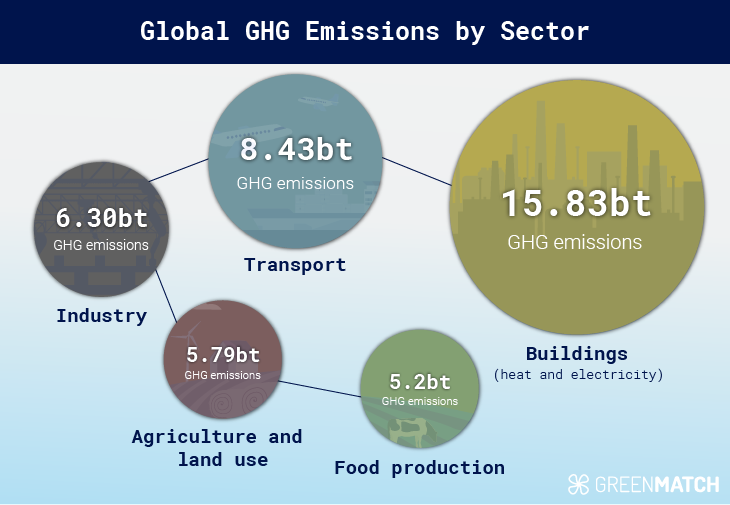
We are also interested in understanding what these industries are doing to decarbonise, reduce pollution levels, and sustainably manage the resources they exploit.
In most cases, some key technologies are making their way to becoming industry standards, provided that supportive policy and sizeable investments are implemented.
It’s also clear that these industries are interlinked. This means common issues like energy usage across all industries are linked to the exploitation of fossil fuels. Therefore, transitionary measures, or national targets, that reduce fossil fuel use would impact most industries.
Our Approach
We’ve analysed some key indicators related to all or some of these industries to measure pollution levels. These include:
- Greenhouse gas emissions
- CO2 emissions
- Biodiversity loss
- Water stress
- Crude deaths
- Levels of waste
CO2, CO2eq, or GHG?
Greenhouse gases absorb and re-emit heat, warming the planet's surface, i.e. global warming. GHGs do occur naturally, but industrial activities such as deforestation or burning fossil fuels increase GHG emissions, rapidly accelerating global warming.
Greenhouse gas emissions are measured in carbon dioxide equivalents (CO2eq). This bundles non-CO2 gases in one unit based on the amount of CO2 that would cause the equivalent global warming impact. Other examples of greenhouse gas emissions include methane (CH4) and nitrous oxide (N2O).
Carbon dioxide is the most commonly emitted GHG, accounting for about 74% of total global emissions, according to Our World In Data. Therefore, CO2 emissions are often measured alone. Throughout this article, emissions from CO2 and GHG have been included.
Types of Pollution
CO2 and GHG emissions are effective measures of global warming, but this is not the only indicator of pollution. That's why we’ll look into the impacts on air, water, and land to understand the scope of pollution from these industries.
Air pollution
Air pollution is the most severe type, given the danger air pollutants (such as CO2, methane, and particulate matter) cause to human health and global warming.
According to the World Health Organisation, 7 million deaths yearly have been linked to air pollution. Pollution in the air has been proven to impact infant mortality rates, respiratory disorders, and mental health disorders, among many more.
Air pollution is most prevalent in urban areas, identified by smog levels, but toxic particulate matter can be found in even the most rural areas. 99% of people currently breathe air that exceeds the WHO’s guideline limits for pollutants. People living in low- and middle-income countries are the most affected.
Water pollution
Water pollution is the contamination of waterways or bodies of water in the environment. Water pollution degrades water quality, impacting human health and ecosystem health.
Common pollutants include nutrients and chemicals from agriculture, leached contaminants from landfills, toxic dyes and microplastics from waste, or oil pollution from industrial spills,
Water pollution has many effects:
- Human health impacts: diseases such as cholera and typhoid from human and animal waste
- Eutrophication: the presence of industrial residues in water depletes oxygen levels and starves marine and plant life
- Ocean acidification: the oceans absorb CO2 from the atmosphere, altering the pH levels and impacting marine life and food chains
- Chemical and heavy metal contamination
- Marine waste starving or suffocating marine life
Soil pollution
Soil becomes polluted from agricultural residues, such as manure and pesticides, industrial waste, heavy metals and urban waste.
Pollution in the soil causes biodiversity loss, contamination of water storage and nutrient depletion. Common agricultural practices such as monocropping lead to soil erosion, which is largely irreversible and has catastrophic impacts on the global food system and climate change.
With that being said, let's look at the top polluting industries.
1. Energy Sector: Leading Polluter
Unsurprisingly, energy production remains atop pollution rankings. Fossil fuel combustion for electricity and heat generation accounts for approximately 75% of global greenhouse gas emissions. Despite renewable energy growth, coal-fired power plants continue operating in many countries, releasing harmful pollutants and carbon dioxide.
Moreover, energy in residential and commercial buildings provides heating, cooling, and power. The global energy (and electricity) mix is typically made from nuclear, renewable, or fossil fuels.
In 2019, fossil fuels- such as natural gas, oil, and coal- comprised over 80% of the global energy supply. 25% of the CO2 emissions from burning these fossil fuels was used for heat and electricity in buildings. This put it ahead of transport and manufacturing in both cases.
The generation of electricity in thermal power plants is another major source of pollution and climate change. In 2021, 64% of the global power mix came from thermal power generation, with a significant share used to power buildings.
Thermal power plants emit huge amounts of nitrogen oxides, CO2, and other harmful pollutants. These power plants are also major water and land polluters.
For example, when wastewater is discharged into waterways, ecosystems are disrupted by changes in water temperature. Toxic components of waste also kill marine life or affect plant growth.
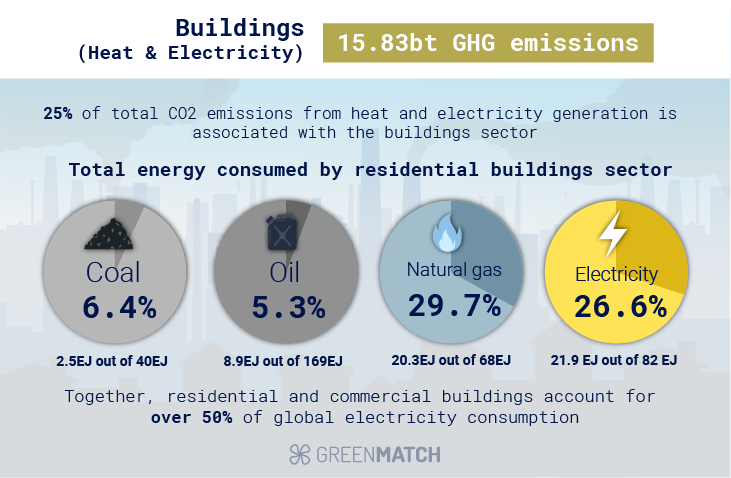
IEA (2021), Greenhouse Gas Emissions from Energy Data Explorer: https://www.iea.org/data-and-statistics/data-tools/greenhouse-gas-emissions-from-energy-data-explorer
IEA (2021), Key World Energy Statistics 2021: https://www.iea.org/reports/key-world-energy-statistics-2021
United Nations, Facts and Figures: https://www.un.org/en/actnow/facts-and-figures
Despite the rapid growth of renewable energy sources, many countries still heavily rely on coal-fired power plants:
- Coal remains a significant electricity source in China, India, and Southeast Asia.
- In 2023, coal accounted for about 36% of global electricity generation.
- Coal-fired plants emit large quantities of CO2 and release other harmful pollutants like sulfur dioxide, nitrogen oxides, and particulate matter.
Based on today's technologies, switching to alternative energy sources for heat and electricity is possible.
In most cases, the low-carbon heating option in most cases is to install a heat pump. For instance, the emissions of an air source heat pump vs a gas boiler are far lower (by 1,650kg per year). However, different solutions will suit buildings differently. This will typically depend on the building's location, size and condition.
Therefore, a combination of new technologies is expected to replace traditional forms of heat in buildings. Other low-carbon options include biomass heating, ‘green’ hydrogen, or solar thermal systems for hot water.
The cost of installing a heat pump remains the primary challenge in ensuring widespread adoption. A traditional gas boiler costs significantly less upfront and will appeal to more homeowners.
Moreover, installing a heat pump might require significant energy-efficiency improvements first. This means many existing buildings must undergo retrofits, which only adds to the overall costs.
Governments and industry actors can help heat pumps become more commercially viable with the following measures:
- Minimum energy performance standards across buildings
- Governments finance schemes (heat pump grants) to help cover costs
- Redirecting investments from energy-intensive or fossil-fuel-based building projects
Renewable electricity can be provided by installing domestic solar panels. Once installed, renewables provide a free renewable electricity supply to a building.
Renewable power capacity within the power mix has steadily reached new records year-on-year. According to the International Energy Agency (IEA), renewable electricity capacity is set to rise 60% from 2020 levels by 2026. This will match the combined capacity of fossil fuels and nuclear energy.
2. Transport
Transportation accounts for over 20% of global CO2 emissions from burning fossil fuels, making it the second-largest source of pollution after the energy sector. In 2021, road vehicles alone contributed 12% of global GHG emissions, making road transportation the second-largest contributor to global emissions, behind coal-fired power plants.
Since 1990, global transportation CO₂ emissions have increased by more than 70%. In 2022, these emissions rose by almost 5%, rebounding from the reductions during the COVID-19 pandemic.
Global transportation-related emissions totaled 7.97 billion metric tons of carbon dioxide (GtCO₂) in 2022. Cars and vans were the biggest source of transportation emissions that year, accounting for approximately 48 per cent of global transportation emissions
As the global population increases, so too does our demand for transport, be it passenger travel or freight. The International Energy Agency (IEA) expects global transport to double by 2070. Car ownership rates will increase by 60%, and demand for aviation (passenger and freight) will triple.
Modes of transport largely operate from burning petroleum products in combustion engines. This has created a huge air pollution problem, especially in urban areas.
Production of this fuel in refineries releases toxic gasses and creates air pollution. What's more, these refineries spend huge amounts of energy and generate toxic waste, which is still disposed of illegally in some cases. Then comes the direct emissions from burning the fuel in combustion engines to power transport.
Of the various modes we use, road transport alone accounts for nearly 75% or three-quarters of transport emissions. This amounts to 15% of CO2 emissions globally, most of which comes from passenger travel.
Specific Modes of Transport
- Road Transport: This mode is the primary source of transportation emissions, responsible for 74.5% of all CO₂ emissions in the transport industry. Light-duty vehicles, such as passenger cars, are the main contributors, with emissions increasing by 1% yearly since 2010.
- Aviation: Aviation emissions have doubled in the past 30 years and were significantly impacted by the COVID-19 pandemic, with a 58% reduction in 2020. However, emissions rebounded by 24% in 2021 and 48% in 2022. Flight numbers are expected to return to 2019 levels by 2025.
- Maritime Transport: Emissions from international maritime transport are also rising, with projections indicating continued growth due to limited prioritization in national policies.
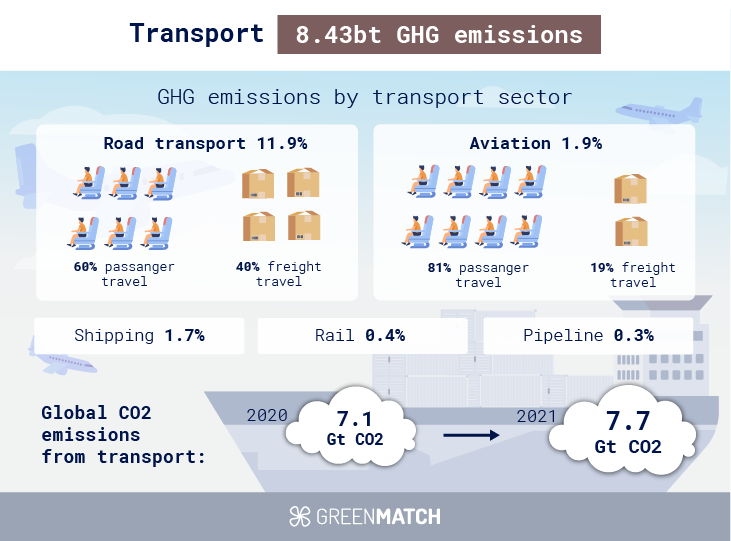
Our World in Data (2020), CO₂ and Greenhouse Gas Emissions: https://ourworldindata.org/co2-and-other-greenhouse-gas-emissions
IEA (2022), Transport, IEA, Paris https://www.iea.org/reports/transport
Electric vehicles (EV) and hydrogen fuels offer the greatest potential to decarbonise road and rail in the coming decades. The IEA estimates that rail emissions can be eliminated by 2050 and emissions from cars and buses by 2070.
In 2021, EV sales doubled from 2020 figures to 6.6 million. In the first quarter of 2022, sales were up 75% from the year before. By 2030, 30% of road transport vehicles are expected to be electric vehicles, although 60% is needed to reach net zero CO2 emissions by 2050.
According to the IEA, this growth can largely be attributed to government policy support promoting EV adoption. This could involve:
- Subsidies and incentives, which doubled in 2021 globally to US$30 million.
- Phase-out of combustion engines through target setting.
- Vehicle efficiency or CO2 standards.
However, there must be vast upscaling across the EV supply chain to meet net-zero targets. Meanwhile, all processes must remain sustainable and resilient. The IEA suggests funnelling private investments into sustainable mining practices and fast-tracking permitting procedures.
EV charging infrastructure must also continue to expand to meet the production demands. Enhancing charging infrastructure and smart grid technology helps to support growing EV fleets.
The electrification of public transport and widespread adoption of cycling must become the norm in urban areas. Electric buses and trucks are emerging as a competitive alternative to combustion engines. However, this can be supported by effective policy, such as introducing minimum CO2 standards.
These alternatives vastly improve the quality of life in our cities. Implementing them improves transport routes, reduces pollution, and provides cheaper travel.
Most difficult to decarbonise is long haul road freight, aviation and shipping. Hydrogen fuel and electric batteries offer the most potential but will take time to develop. This is due to the sheer power required to fuel these modes of transport.
As time goes on, these sub-sectors will become the main source of emissions from transport. The IEA predicts that carbon capture and storage in other parts of the energy system will help stabilise these emissions in the future.
3. Heavy Industry and Manufacturing
Manufacturing involves the extraction and processing of natural resources into material goods. Typical resources might include metals for electronics, or sand and gravel used in construction.
A functioning manufacturing system supports economic growth and underpins social progress. This helps improve the standard of living in countries everywhere.
However, extraction of non-regenerative materials is often energy-intensive and happens at unsustainable rates. What's more, it creates untenable amounts of air, soil and water pollution, as well as greenhouse gas emissions and damage to ecosystems.
Therefore, the material and economic gains promised by large scale manufacturing actually result in a net loss for humanity.
This is especially the case considering the toll on human health industrial pollution creates. Respiratory disorders, cardiovascular disorders, and birth defects have been linked to industrial pollution.
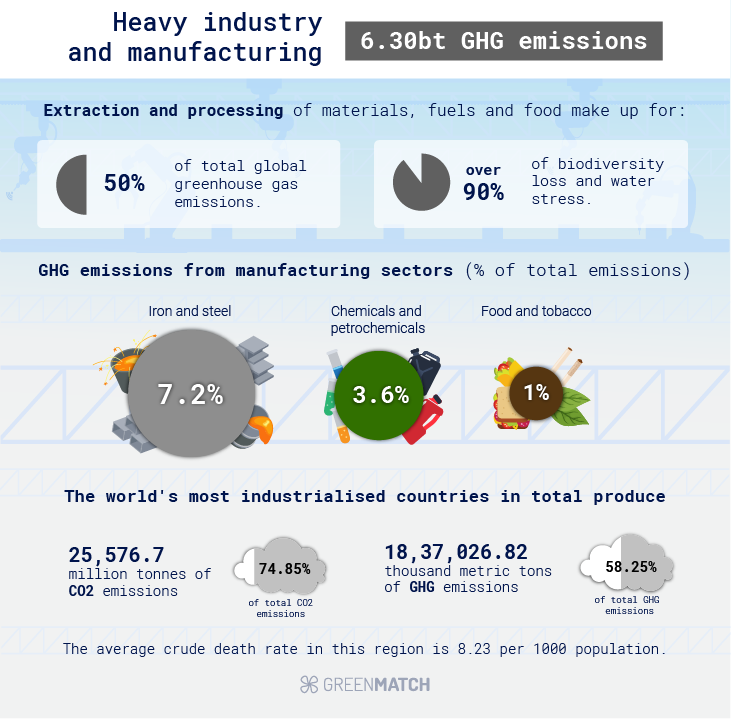
United Nations, Facts and Figures: https://www.un.org/en/actnow/facts-and-figures
Our World in Data (2020), CO₂ and Greenhouse Gas Emissions: https://ourworldindata.org/co2-and-other-greenhouse-gas-emissions
National Library of Medicine (2021), Is industrial pollution detrimental to public health?: https://www.ncbi.nlm.nih.gov/pmc/articles/PMC8213381/#CR6
The manufacturing industry must extract and process resources more sustainably. Meanwhile, it must also boost productivity to support growing economies and meet supply demands.
Key to addressing these issues is improving the efficiency of operations across the lifecycle of the materials.
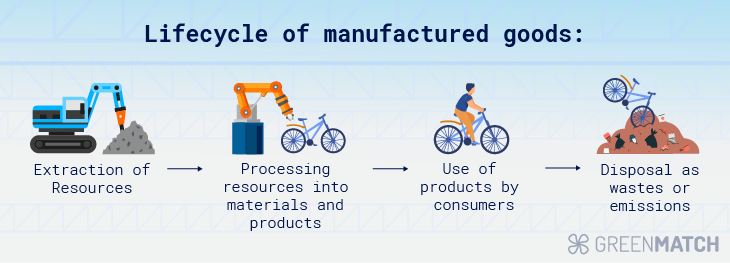
Improving the efficiency of the whole manufacturing system involves some key system-wide strategies:
- Dematerialisation | savings and reduction of material and energy use.
- Re-materialisation | reuse, remanufacturing and recycling.
Standardising these strategies creates a circular economy where products are recycled, remanufactured, and redistributed. This helps improve production efficiency and saves precious resources. Currently, some companies incentivise products to be returned for money, where they can then be repaired for re-use.
A circular economy also means less need for the materials, energy, land, water and waste associated with manufacturing. This is partly because the lifetime of products is prolonged and continually restored.
Fore-fronting alternative technologies through research and development can help establish a circular economy. Efficient technologies can also be supported by policies such as minimum efficiency standards.
For example, industrial, low-carbon electricity is already available. Electric-arc furnaces can operate at over 1000°C heat and use less electricity than blast furnaces, making them more efficient. These can be used for steel-making and melting.
Steel, cement, glass and chemicals can be processed using energy from hydrogen. This is a low-carbon fuel that also burns at very high temperatures.
Efficient manufacturing helps retain the value of the materials we use, which thus reduces environmental impacts. Moreover, associated costs are reduced, and more jobs are created by scaling these technologies.
4. Agriculture
Our food system and wider land use activities must rapidly adapt in the face of many interlinked challenges. These include feeding a growing population, combating the worst effects of climate change, and reducing the industry's environmental impacts.
Changing climate and the prevalence of extreme weather events intensify these issues. Most notably, reduced crop yields exacerbate food shortages and deplete food quality. Changing climate zones also help spread diseases and infestations to further reaches of the planet.
The mismanagement of land use is a major contributor to these climate problems. By-products such as fertilisers, pesticides, and manure create toxic run-off into the soil and waterways. These by-products can also have harmful greenhouse gas effects.
Around 22% of GHG global emissions came from agriculture, forest and other land use in 2019, half of this from deforestation and most of the rest from fossil fuel combustion.
Practices such as monocropping also increase the risk of soil erosion. This, combined with extreme weather events, can lead to desertification.
Industrial land use, such as palm oil plantations and mining, are also major contributors to deforestation. This degrades the land, threatens biodiversity, and releases tonnes of CO2 into the atmosphere at an ever-alarming rate.
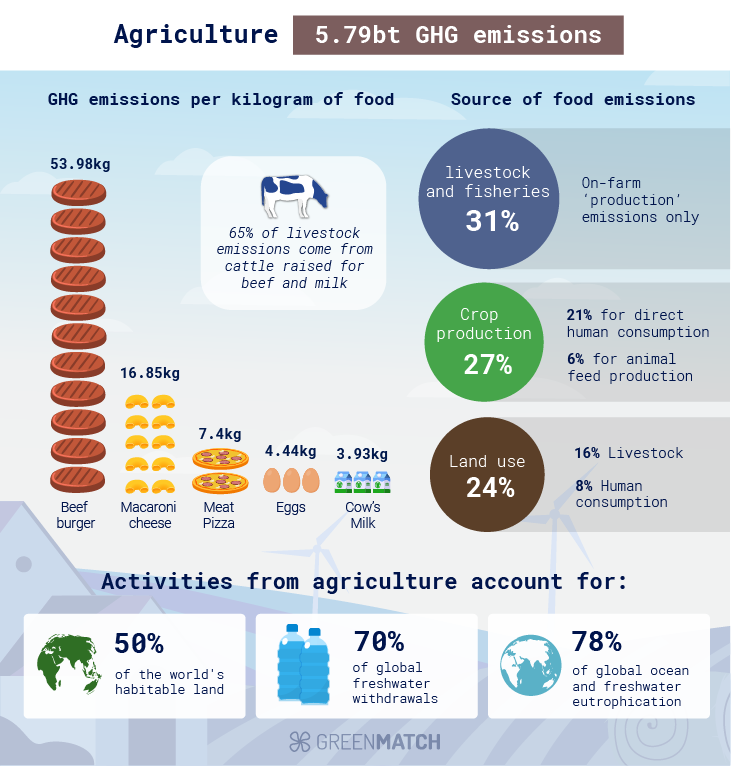
Our World In Data, Greenhouse gas emissions per kilogram food: https://ourworldindata.org/explorers/food-footprints
Food and Agriculture Organisation of the United Nations, Key facts and findings: https://www.fao.org/news/story/en/item/197623/icode/
Our World in Data (2020), CO₂ and Greenhouse Gas Emissions: https://ourworldindata.org/co2-and-other-greenhouse-gas-emissions
Our World in Data (2020), Environmental Impacts of Food Production: https://ourworldindata.org/environmental-impacts-of-food
Various strategies can increase productivity and reduce emissions across agriculture and land use. This urgency is critical as these sectors must supply growing demands for food and resources. According to the International Panel on Climate Change (IPCC), this is possible while reducing emissions by up to 30% to limit global warming to 2°C or lower.
Forestry
Maintaining forests is vital to ensure that CO2 is sequestered from the atmosphere. Therefore, the agriculture and land use industry must continue to develop sustainably managed “working forests”. These can produce wooden products that store CO2 even after the tree is cut.
Working forests can be sustainably managed by ensuring trees are replanted in place of those cut down. Certain forest areas can also be maintained to protect biodiversity and prevent nutrient run-off.
Soils
Carbon sequestration also happens within the soil. Soil erosion, deforestation, and tillage/ploughing all release carbon from the soil.
Farming crops and pasture land can reduce these harmful effects on trees, which is known as agroforestry. This also helps prevent further deforestation.
Other methods include efficient crop/livestock rotation and increasing crops, such as legumes, which increase soil fertility. Productivity can also be increased through improved irrigation methods and organic fertilizers.
Increasing crop yields sustainably involves new pest control and prevention methods. This reduces chemical pesticide use and prevents pollution as a result.
Livestock
Half of direct agriculture emissions come from livestock. Digestive processes in livestock release methane, a greenhouse gas, as a by-product into the atmosphere. Improving the digestibility of animal feed or methane-reducing supplements can help reduce these emissions.
While these advances help curb livestock emissions, meat consumption worldwide continues to grow. This is especially the case for beef, which has the highest GHG emissions intensity per kilogram compared to other food products.
The production of beef also requires large amounts of vital resources- water, land and energy. Therefore, public health policies and outreach campaigns must push for reduced beef consumption.
Nitrous oxide and methane can also be released from manure decomposing under low-oxygen conditions- such as in confined spaces where livestock is kept. Large piles of manure dumped into waterways also create soil and water pollution. Treating manure with anaerobic digesters can help mitigate these emissions.
According to IPPC, the agriculture and land use industries have been slow in implementing these strategies and others like them. This is despite them costing relatively little to put into place.
The IPPC has also criticised governments for not acting fast enough to oversee these changes and has called for governments to increase financial support for sustainable farming technologies, funded by redirecting non-climate related subsidies.
5. Food Production
Food production, as we’re calling it, includes transportation, packaging, retailing, cooking and waste of food products.
Reduced transport costs and improved efficiency across supply chains have made it easier to expand food supply chains internationally. As a result, ‘food miles’, representing the fuel spent transporting food products, continue to increase.
Refrigerated products such as dairy, fruits and vegetables have 230% higher emissions of CO2e than non-refrigerated products. Therefore, such products tend to have the highest food miles.
Typical food packaging such as glass, plastics or paperboard also uses many resources like water, energy and petroleum. This production also creates a lot of GHG and CO2 emissions, as well as wastewater and toxic waste, which create pollution.
Most packaging that's produced will be discarded after use, which has caused a massive global waste issue and catastrophic environmental impacts.
Typically ending up in landfills, discarded packaging might take a long time to decompose, or never at all in the case of plastics. Instead, chemicals leach into the surrounding environment, polluting soils, water and the air.
In fact, in our oceans, plastic pollution alone has been deemed a “planetary crisis” by the United Nations. Plastic ends up in the oceans through drainage systems, especially from littering or from illegal dumping. Between 1950-2017, 7 billion of the 9.2 billion tonnes of plastic produced ended up as waste, the UN reports.
Decomposing plastic also sheds microplastics. This is often fatal for marine life and impacts soil fauna growth. Microplastics have also made their way into human diets, posing health risks from the toxic chemicals they absorb.
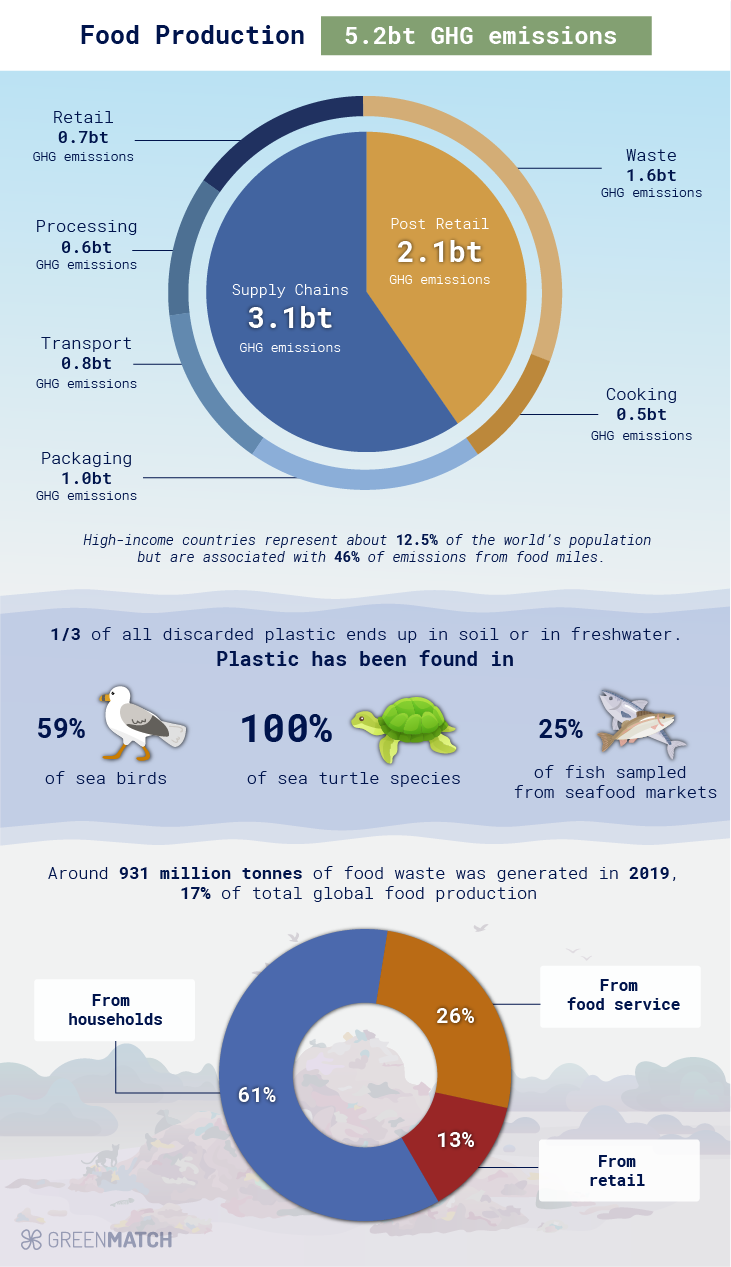
Our World in Data (2021), How much of global greenhouse gas emissions come from food?: https://ourworldindata.org/greenhouse-gas-emissions-food
Nature Food, Global food-miles account for nearly 20% of total food-systems emissions: https://www.nature.com/articles/s43016-022-00531-w.epdf?
Ocean Conservancy (2018), Fighting for Trash Free Seas: Ending the Flow of Trash at the Source: https://oceanconservancy.org/trash-free-seas/
UN Environment Programme (2021), UNEP Food Waste Index Report 2021: https://www.unep.org/resources/report/unep-food-waste-index-report-2021
Food shortages, malnutrition, overexploitation of natural resources, and huge amounts of waste all point to an unbalanced and unsustainable food production industry.
There are many approaches to improving the production and distribution of food. While prioritising locally sourced items is important, the mode of transport and its fuel efficiency must also be accounted for.
For example, food items within Europe will travel less distance from those outside Europe. However, road transport has higher emissions than cargo ships, meaning European food items might have more associated emissions. What’s more, production and retail can also be intensive processes that add to the environmental impact of products.
To help combat this, manufacturers can get true insights into food products’ environmental impacts using life-cycle assessment (LCA) tools. These consider the entire lifecycle of a product and measure everything from the release of toxins and GHGs to the use of natural resources. Therefore, LCAs enable industry stakeholders to make conscious decisions as to the impacts of their activities.
Non-thermal preservation technologies, such as High Pressure Processing, have also become more accepted in food processing. Such technologies inactivate microorganisms that would usually degrade the quality of food. As such, food is preserved for longer. Compared to conventional preservation methods, non-thermal preservation uses far less energy during processing and storage since they are effective even in mild temperatures. It also addresses wider issues by reducing demand and preventing food losses.
Industrial smart meters can be also deployed to reduce energy consumption during production. Given their economic benefits, smart meters are becoming more widespread since they show the consumption rates of resources, such as water or electricity. This allows companies to strategise the best ways to optimise productivity.
Reducing waste
New waste management techniques such as anaerobic digestion and biodegradation convert waste into bioenergy as liquid or gas biofuels.
It’s also important that plastic and heavy emitting materials are replaced with wood, paper-based packaging or aluminium for metal products. These materials can biodegrade faster, are easily recyclable and come from renewable sources (as long as the forests are managed sustainably). Alternative packaging can also derive from sources such as seaweed.
Plastics made from polymers can also continue to be produced from renewable sources. The widespread adoption of plastic recycling must also become more normalised to prevent the overexploitation of natural materials for packaging. This also keeps plastics from becoming permanent waste.
6. Fashion Industry: Hidden Polluter
The fashion industry accounts for an estimated 3-8% of global carbon emissions, with projections suggesting it could increase to 25% by 2050 if current trends continue.
In 2021, the fashion industry was responsible for approximately 1.8% of global greenhouse gas emissions. The Apparel Impact Institute projects that the industry's global emissions will increase by 50% by 2030.
Moreover, fast fashion has emerged as one of the most significant yet often overlooked contributors to global pollution and environmental degradation. As consumer demand for trendy, affordable clothing continues to rise, the environmental costs of this industry have become increasingly apparent.
The industry produces around 92 million tonnes of textile waste annually. In the UK alone, approximately 350,000 tonnes of clothing waste are sent to landfills annually.
The average American throws away about 81 pounds (37 kg) of clothing annually.
Globally, 87% of the total fibre input used for clothing is either landfilled or incinerated, with less than 1% recycled into new garments. The industry uses 43 million tonnes of chemicals annually in clothes production processes.
Key Environmental Impacts
- Greenhouse Gas Emissions: The fashion industry accounts for an estimated 8-10% of global carbon emissions, surpassing the combined emissions of international flights and maritime shipping.
- Water Pollution: Textile production is responsible for approximately 20% of global clean water pollution from dyeing and finishing products. A single laundry load of polyester clothes can release up to 700,000 microplastic fibres into water systems.
- Water Consumption: The industry uses about 93 billion cubic meters of water annually, equivalent to the needs of 5 million people.
- Textile Waste: Globally, 85% of textiles end up in landfills yearly. The equivalent of one garbage truck full of clothes is burned or dumped in a landfill every second.
- Chemical Usage: The fashion sector uses an estimated 43 million tonnes of chemicals annually in clothes production.
Despite these efforts, the fashion industry faces significant challenges in meeting climate goals. Only a few leading brands are on track to reduce greenhouse gas emissions sufficiently to limit global warming to 1.5 degrees Celsius.
To address these challenges, industry leaders and consumers alike are exploring more sustainable approaches:
- Circular Economy Models: Emphasising recycling, upcycling, and extended product lifecycles.
- Sustainable Materials: Increasing use of organic, recycled, and innovative eco-friendly fabrics.
- Supply Chain Transparency: Implementing blockchain and other technologies to enhance traceability.
- Consumer Education: Promoting awareness of sustainable fashion choices and responsible consumption.
As the industry evolves, brands must adopt comprehensive sustainability strategies that address environmental impacts throughout the product lifecycle. Simultaneously, consumers can contribute by making informed purchasing decisions, prioritising quality over quantity, and supporting brands committed to sustainable practices.
7. Technology Sector
Growing demand for electronic devices and data centres has significantly increased energy consumption and waste production, positioning technology as an emerging concern among most polluting industries. This sector's environmental impact stems from two primary sources: energy-intensive data centres and environmentally damaging rare earth metal mining practices.
The production and disposal of electronic devices contribute significantly to environmental degradation. In 2022, the world generated 62 million tonnes of electronic waste (e-waste), up 82% from 2010. Unfortunately, less than a quarter of this e-waste was recycled, with the majority ending up in landfills or being handled improperly, leading to severe pollution and health risks
Data Centres: Hidden Energy Guzzlers
Data centres, the backbone of digital infrastructure, consume vast amounts of electricity. Recent estimates suggest global data centre electricity use reached 200-250 TWh in 2023, accounting for approximately 1-1.3% of global final electricity demand.
For instance, the combined electricity use by tech giants like Amazon, Microsoft, Google, and Meta more than doubled from 2017 to 2021, reaching around 72 TWh in 2021. Despite improvements in energy efficiency, the demand for data centre services continues to grow, driven by emerging technologies such as AI, virtual reality, 5G, and blockchain.
UK data centres alone consumed an estimated 12 TWh in 2023, equivalent to powering over 3 million homes annually. Rapid digitisation across industries continues driving exponential growth in data processing and storage needs. Cloud computing, artificial intelligence, and Internet of Things (IoT) technologies further accelerate this trend. Without intervention, data centre energy consumption could skyrocket to 8% of global electricity use by 2030.
Rare Earth Metals: Environmental Cost of Tech Components
Mining for rare earth metals often involves digging vast open pits, leading to ecosystem disruption and contamination of the environment. For every tonne of rare earth elements produced, approximately 2,000 tonnes of toxic waste are generated. This waste can infiltrate soil and water, causing long-term environmental damage.
In addition, manufacturing electronic devices relies heavily on these rare earth elements, critical components in smartphones, laptops, and renewable energy technologies. This waste can infiltrate soil and water, causing long-term environmental damage.
However, extracting these metals often involves environmentally destructive practices:
- Water Pollution: Mining operations can contaminate groundwater and surface water with toxic chemicals and heavy metals.
- Soil Degradation: Open-pit mining and improper waste disposal lead to soil erosion and biodiversity loss.
- Radioactive Waste: Some rare earth deposits contain radioactive elements, creating hazardous byproducts.
China dominates rare earth production, accounting for over 80% of the global supply. However, recent discoveries in Norway and Sweden may shift production dynamics, potentially impacting environmental practices in extraction.
Addressing Environmental Concerns
The technology sector must prioritise sustainability to mitigate its growing environmental impact:
- Energy Efficiency: Implementing advanced cooling systems and optimising server utilisation can significantly reduce data centre energy consumption.
- Renewable Energy: Transitioning data centres to renewable power sources mitigates carbon emissions. Several tech giants have pledged to achieve 100% renewable energy use in the coming years.
- Circular Economy: Promoting device recycling and extending product lifespans reduces e-waste and demand for new raw materials.
- Sustainable Mining: Developing environmentally friendly extraction methods and enforcing stricter regulations on rare earth mining can minimise ecological damage.
- Green Computing: Designing energy-efficient hardware and software optimises resource utilisation across the technology ecosystem.
As the technology sector continues expanding rapidly, addressing its environmental impact becomes increasingly crucial. Balancing innovation with sustainability will be key to ensuring the tech industry's long-term viability without compromising the planet's health.
Conclusions
As you can see, multiple and far-reaching solutions must be implemented within each polluting industry. Implementing new technologies, conserving natural resources, and limiting the use of toxic materials concerns many stakeholders- from producers to consumers.
There are glimmers across these industries of change, but rapid acceleration is needed to limit further warming before there’s no going back.
In 2022, we’ve seen governments and industries respond with sanctions to Russia’s war in Ukraine. Because of this, global demand for fossil fuels will peak or plateau in upcoming outlook scenarios, according to IEA. This shows us that it can be done quickly and that a more secure, sustainable future may be in reach.

Ciaran is a content writer at GreenMatch. Whether writing about sustainable aviation fuel or heat pumps, Ciaran has passion for informing readers about pivotal technologies that are reshaping our world.
We strive to connect our customers with the right product and supplier. Would you like to be part of GreenMatch?




